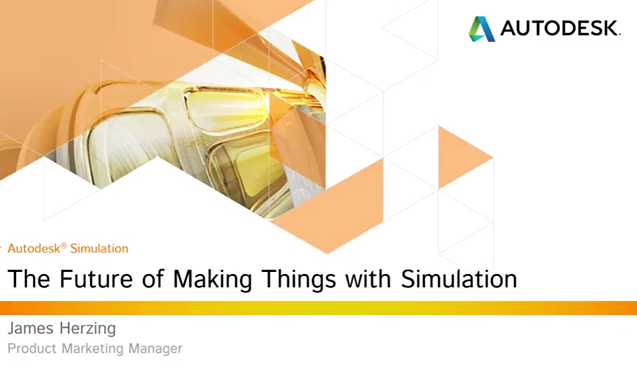
James Herzing has been a part of the Autodesk Simulation team since 2009 and understands the rapid evolution of simulation. From Autodesk generative design to event simulation, Autodesk is changing the way engineers design and the future of make things.
In this recap of Autodesk Virtual Academy, you’ll learn how Simulation software now allows you to lighten your design, optimize flow, and reduce failure. Let’s take a look at some new introductions previously thought impossible.
Watch the Webcast
We understand things come up and you’re unable to tune in to the live webcast each Thursday. Check out the full presentation below and make sure you subscribe to our YouTube Channel so you never miss a training.
A New View of the Product Lifecycle
Autodesk has a very specific way they view product lifecycle and the future of making things. Traditional methods of creating products starts in the concept phase. We may think of concepts as drawings on a bar napkin, which then leads to the design process. You likely use traditional CAD software to design versions of your concept, bringing it closer to reality. The next step is production, and finally selling your product to the market. Of course, almost all products eventually retire after a life of operation.
Autodesk’s Future of Making Things platform introduces a whole new approach to this model. You can now start planning for configurable and personalized components during concept. During the design phase, you can collaborate with such tools as Fusion Team and BIM 360 Team. And while many look to simulation to validate products later in the lifecycle, Autodesk’s portfolio encourages you to look to simulation earlier in the process. This cuts down costs associated with making changes later in the design process.
One of the biggest areas Simulation can help in is reducing warranty issues. In regards to warranty, issues typically are due to one of the following four: inadequate design, improper material selection, lack of testing/design, and specifying incorrect parts. Autodesk’s Simulation portfolio offers tools that can improve end results with these four scenarios.
Simulation also plays a large role in improving product performance. When it comes to electronic cooling, products can be designed to perform at proper temperatures. Miscalculations in cooling can lead to product failure earlier than planned. Thermal expansion can also be evaluated using Simulation tools. Warping and wearing can be accounted for to avoid parts coming in contact with each other.
Simulation leads to innovation, and James uses the example of the shape generator feature to explain this. Shape generator lets you create the best possible design quickly and optimize it to the specified constraints. This creates more time to innovate and improve your designs.
At the end of the presentation, James took some time to answer some questions from viewers looking to improve their workflows using Simulation tools as the future of making things.
Q&A
What kind of Simulation tools are available in Fusion 360 vs. Inventor?
Fusion 360 is consistently improving with updates every 6 weeks and is continuing to improve its Simulation capabilities. For example, Fusion 360 has introduced event simulation, which is not part of Inventor’s Simulation capabilities. Their team is really great at highlighting new and upcoming features in their Fusion 360 Blog.
Is Autodesk going to include elements such as sand, gravel, etc. in its CFD tool?
It’s too early to announce any of the features for upcoming releases, but check back in a few months and we’ll be going over what’s new for all major products. In the meantime, make sure you head over to the Simulation Ideastation and add ideas on what you’d like to see implemented.
Subscribe to the Autodesk Virtual Academy community and never stop learning.
I am very interested in learning all about autocad products.